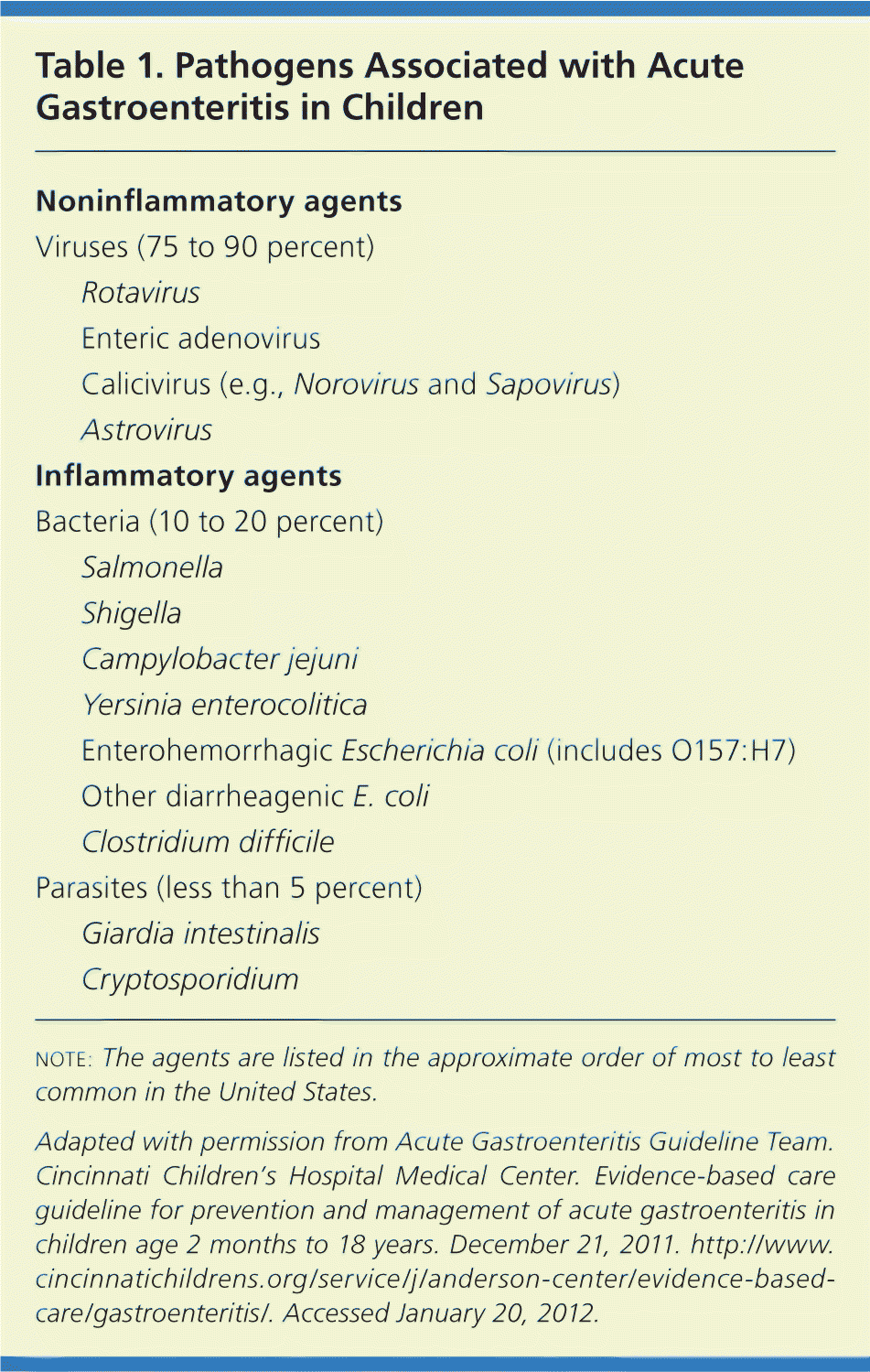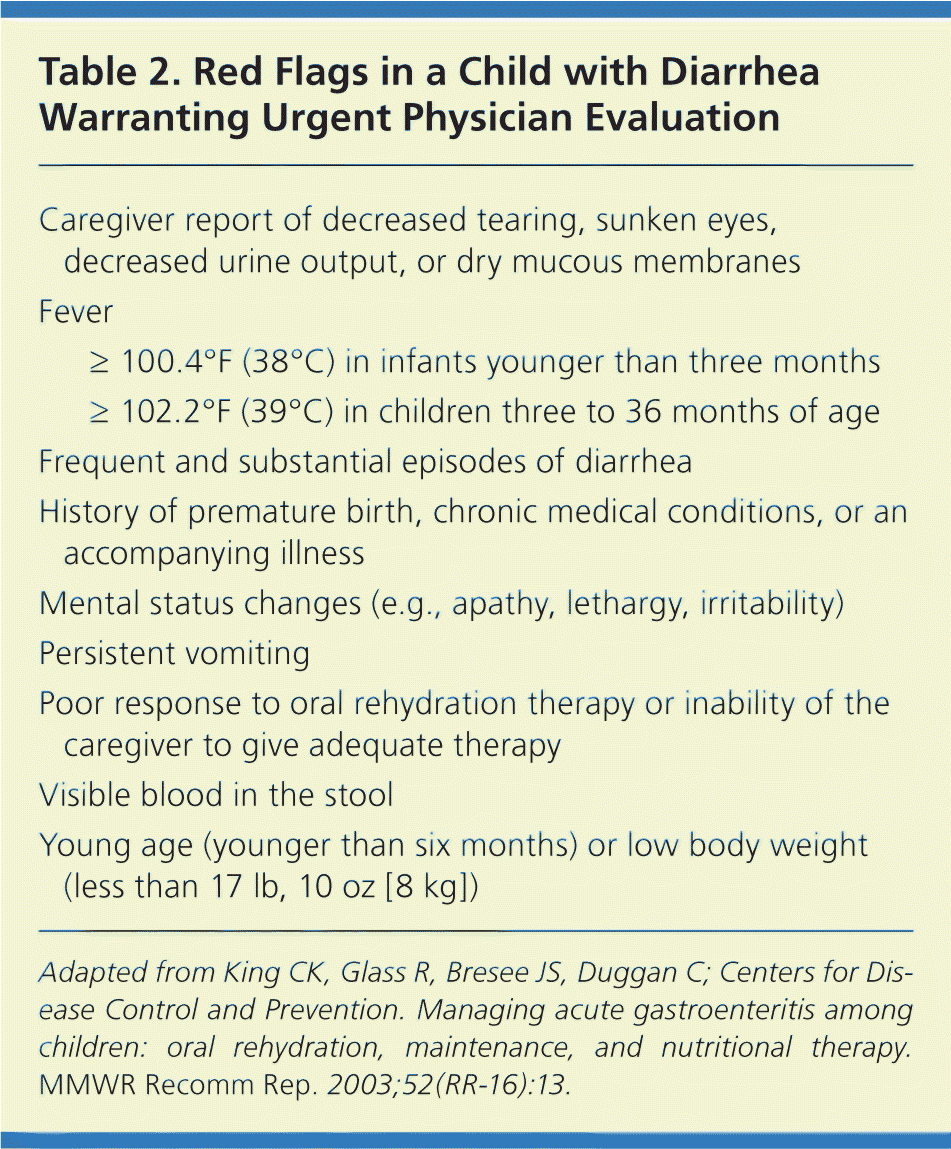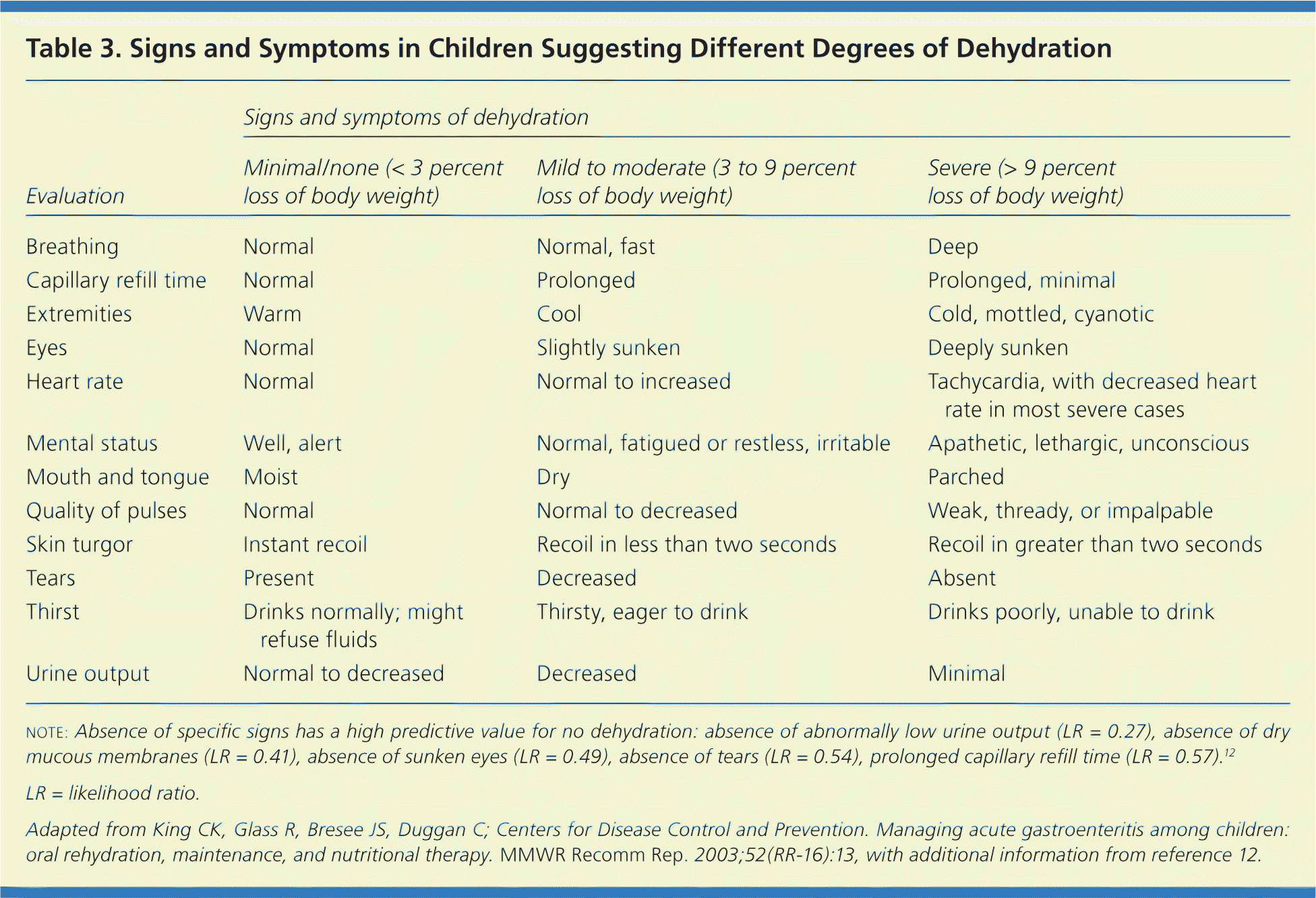
Am Fam Physician. 2012;85(11):1059-1062
This is part I of a two-part article on gastroenteritis in children. Part II, "Prevention and Management," appears in this issue of AFP.
A more recent article on gastroenteritis in children is available.
Author disclosure: No relevant financial affiliations to disclose.
Acute gastroenteritis in children is a major cause of morbidity in the United States. Viral infections, primarily from rotavirus, cause 75 to 90 percent of cases. The remaining infections are largely bacterial, with as many as 10 percent of cases secondary to diarrheagenic Escherichia coli. The history and physical examination of children with gastroenteritis should focus on assessing for the presence and degree of dehydration and determining the underlying etiology. The child's weight during the illness versus posttreatment is often used to evaluate degree of dehydration retrospectively. The three examination signs that best suggest dehydration in children are an abnormal respiratory pattern, abnormal skin turgor, and prolonged capillary refill time, although parental report of the child's history is also helpful in the assessment. In general, measuring serum electrolyte levels usually is unnecessary in children with mild to moderate dehydration. Laboratory tests are recommended only when severe dehydration is suspected; in such cases, intravenous fluids would be warranted. Although it is not necessary to routinely obtain stool cultures, they should be collected if diarrhea is persistent.
Acute gastroenteritis in children is often defined as the onset of diarrhea in the absence of chronic disease, with or without abdominal pain, fever, nausea, or vomiting.1 In the United States, the condition is a major source of morbidity and hospitalization in children younger than five years, accounting for approximately 300 deaths, greater than 1.5 million outpatient visits, and 200,000 hospitalizations annually. These hospitalizations lead to $250 million in direct medical costs and $1 billion in indirect costs. Rotavirus infection leads to one-third of all diarrhea-related hospitalizations among children younger than five years.2 Childhood gastroenteritis also is a major cause of morbidity and mortality worldwide, leading to 2.5 million deaths annually in children younger than five years. However, with the increased use of oral rehydration therapy, worldwide mortality has been cut in half over the past 30 years.3 This article, part I of a two-part series, focuses on the evaluation of children with gastroenteritis. Part II discusses therapies for the condition.4
| Clinical recommendation | Evidence rating | References |
|---|---|---|
| A dehydration level of at least 5 percent can be determined if two or more of the following signs are present in a child: overall ill appearance, capillary refill time of greater than two seconds, absence of tears, and dry mucous membranes. | C | 11 |
| The three best examination signs for determining dehydration in children are an abnormal respiratory pattern, abnormal skin turgor, and prolonged capillary refill time. | C | 12 |
| Laboratory tests are recommended only in cases of suspected severe dehydration (greater than 10 percent) for which intravenous fluids and electrolytes are needed. | C | 5, 10 |
| Stool cultures are recommended only for persistent diarrhea (at least 14 days) or if an outbreak of a diarrheal disease needs to be diagnosed (e.g., rotavirus infection). | C | 5, 10 |
Etiology
Acute gastroenteritis in the United States is usually caused by an infection. Viral infections, primarily from rotavirus, cause 75 to 90 percent of infectious diarrhea cases in the industrialized world. Bacterial pathogens cause another 10 to 20 percent of cases, with as many as 10 percent of these occurring secondary to diarrheagenic Escherichia coli (e.g., traveler's diarrhea). Parasites such as Giardia intestinalis and Cryptosporidium cause less than 5 percent of cases.5 The incidence of different pathogens may be affected by season and climate. Rotavirus infection, for example, is primarily a winter disease. The risk of acute gastroenteritis in children is increased in day cares and in impoverished areas with poor sanitation.6,7
The differential diagnosis of acute gastroenteritis in children includes a wide range of gastrointestinal conditions (e.g., inflammatory bowel disease, intussusception, pseudomembranous enterocolitis, appendicitis, food allergy, lactase deficiency) and extraintestinal conditions (e.g., bacterial sepsis, otitis media, pneumonia, meningitis, urinary tract infection). In addition, vomiting by itself can be the first symptom of congestive heart failure, trauma, metabolic disorders, ingestion of a toxic agent, or increased intracranial pressure.
Diarrhea is usually defined as three or more watery or loose stools in 24 hours.5 The volume of lost fluid per day through bowel movements can range from 5 mL per kg of body weight (normal) to 200 mL per kg or greater.8 The electrolyte losses and dehydration associated with untreated diarrhea lead to the primary morbidities associated with acute gastroenteritis. Noninflammatory diarrhea is watery without blood and mucus, and fever is usually absent. It often involves the small intestine and does not cause destruction of the mucosa. In contrast, inflammatory diarrhea causes bloody stools that are usually full of white blood cells. It involves the large intestine and may be accompanied by fever, vomiting, and abdominal pain or tenderness.
Diarrhea that persists for at least 14 days usually is caused by a parasitic infection, whereas diarrhea with neurologic changes typically is caused by toxins. Diarrhea accompanied by symptoms of a systemic illness, such as jaundice, weakness, arthritis, or fever, can have bacterial or viral origins.5,9 Table 1 includes the pathogens associated with acute gastroenteritis in children.5

| Noninflammatory agents | |
| Viruses (75 to 90 percent) | |
| Rotavirus | |
| Enteric adenovirus | |
| Calicivirus (e.g., Norovirus and Sapovirus) | |
| Astrovirus | |
| Inflammatory agents | |
| Bacteria (10 to 20 percent) | |
| Salmonella | |
| Shigella | |
| Campylobacter jejuni | |
| Yersinia enterocolitica | |
| Enterohemorrhagic Escherichia coli (includes O157:H7) | |
| Other diarrheagenic E. coli | |
| Clostridium difficile | |
| Parasites (less than 5 percent) | |
| Giardia intestinalis | |
| Cryptosporidium | |
History and Physical Examination
The objectives of the history and physical examination are to assess whether the child is dehydrated and to determine the etiology of the acute gastroenteritis, if possible. The history should include the following: how often the child is urinating and having bowel movements, whether vomiting is interfering with the child's ability to keep down fluids and solid food, the duration of illness, the nature of the stools (e.g., whether blood or mucus is present), the type of emesis (e.g., whether bile is present), the presence of fever, the child's mental status, any accompanying medical conditions, recent exposure to a potentially untreated or compromised water supply (e.g., travel), availability of a caregiver to provide oral rehydration therapy, and whether oral rehydration therapy has been attempted with any success.1,5,6,10 Specific questions should be asked to rule out other potential illnesses that can cause diarrhea. Caregivers can be interviewed by telephone about the child's symptoms. Red flags that should prompt urgent evaluation by a physician are listed in Table 2.10

| Caregiver report of decreased tearing, sunken eyes, decreased urine output, or dry mucous membranes | |
| Fever | |
| ≥ 100.4°F (38°C) in infants younger than three months | |
| ≥ 102.2°F (39°C) in children three to 36 months of age | |
| Frequent and substantial episodes of diarrhea | |
| History of premature birth, chronic medical conditions, or an accompanying illness | |
| Mental status changes (e.g., apathy, lethargy, irritability) | |
| Persistent vomiting | |
| Poor response to oral rehydration therapy or inability of the caregiver to give adequate therapy | |
| Visible blood in the stool | |
| Young age (younger than six months) or low body weight | |
| (less than 17 lb, 10 oz [8 kg]) | |
The child's weight during the illness versus posttreatment is often used to assess the degree of dehydration retrospectively.11 Dehydration scales from multiple medical organizations use various signs and symptoms to predict levels of clinical dehydration. Although the diagnosis is imprecise, general categories of dehydration are described as none (less than 3 to 5 percent loss of body weight), mild to moderate (greater than 3 to 10 percent), and severe (greater than 10 percent).
One scale commonly used to assess dehydration is from the Centers for Disease Control and Prevention (Table 3).10, 12 In another commonly used assessment scale, the presence of two of four abnormal factors (abnormal overall appearance, capillary refill time of greater than two seconds, absence of tears, dry mucous membranes) has a likelihood ratio of 6.1 (95% confidence interval [CI], 3.8 to 9.8) when determining whether a child has at least 5 percent dehydration.11 The presence of three of the abnormal factors indicates 5 to 10 percent dehydration, and the presence of four factors indicates at least 10 percent dehydration.11,13 Prolonged capillary refill time alone has the highest predictive value, with a likelihood ratio of 4.1.1,11

| Evaluation | Signs and symptoms of dehydration | ||
|---|---|---|---|
| Minimal/none (< 3 percent loss of body weight) | Mild to moderate (3 to 9 percent loss of body weight) | Severe (> 9 percent loss of body weight) | |
| Breathing | Normal | Normal, fast | Deep |
| Capillary refill time | Normal | Prolonged | Prolonged, minimal |
| Extremities | Warm | Cool | Cold, mottled, cyanotic |
| Eyes | Normal | Slightly sunken | Deeply sunken |
| Heart rate | Normal | Normal to increased | Tachycardia, with decreased heart rate in most severe cases |
| Mental status | Well, alert | Normal, fatigued or restless, irritable | Apathetic, lethargic, unconscious |
| Mouth and tongue | Moist | Dry | Parched |
| Quality of pulses | Normal | Normal to decreased | Weak, thready, or impalpable |
| Skin turgor | Instant recoil | Recoil in less than two seconds | Recoil in greater than two seconds |
| Tears | Present | Decreased | Absent |
| Thirst | Drinks normally; might refuse fluids | Thirsty, eager to drink | Drinks poorly, unable to drink |
| Urine output | Normal to decreased | Decreased | Minimal |
A meta-analysis of 13 studies showed that the three best examination signs for determining dehydration in children are an abnormal respiratory pattern, abnormal skin turgor, and prolonged capillary refill time.12 In a child who is potentially dehydrated, the respiratory rate should be obtained to evaluate for hyperpnea (rapid, deep breathing without accompanying signs of respiratory distress), which suggests possible acidosis.10 Abnormal skin turgor is often described as “inelastic skin” or “tenting.” Assessment of skin turgor involves pinching a small fold of skin at the umbilical level and lateral abdominal wall, then promptly releasing it and measuring how long it takes for the skin to return to its normal form (e.g., prolonged, slightly delayed, immediate).13 Capillary refill time is assessed by compressing a superficial capillary bed and counting how many seconds it takes for normal color to return after the pressure is released. Capillary refill time can vary with the site of pressure application, ambient temperature, medication use, lighting, and autonomic changes.12 It is not affected by fever and should be less than one and one-half to two seconds.11 Capillary refill time should be measured on the sternum in infants and on the palmar surface of a finger held at heart level in older children.14
Parental report of the child's symptoms also can aid in assessing for dehydration. A recent study demonstrated that parental reporting of decreased fluid intake, decreased urine output, diarrhea, and emesis during a child's illness is sensitive for identifying clinically important dehydration. A child who has normal tearing as reported by the parents is less likely to have dehydration of 5 percent or greater (negative likelihood ratio = 0.4) or significant acidosis (negative likelihood ratio = 0.1).15
Laboratory Testing
Serum electrolyte measurement is usually unnecessary in children with mild to moderate dehydration. Urine specific gravity and blood urea nitrogen measurements have poor sensitivities and specificities for diagnosing dehydration in children.16 However, a normal serum bicarbonate level (more than 15 to 17 mEq per L [15 to 17 mmol per L]) somewhat reduces the chances of dehydration, with a likelihood ratio between 0.18 (95% CI, 0.08 to 0.37) and 0.22 (95% CI, 0.12 to 0.43).12 A serum bicarbonate level of less than 13 mEq per L (13 mmol per L) increases the chances that outpatient oral rehydration therapy will be ineffective.17 Laboratory values may be helpful in evaluating severe dehydration, for which intravenous fluids and electrolyte supplementation (especially potassium, bicarbonate, and sodium) are needed. Although it is not necessary to routinely obtain stool cultures and send stool for ova and parasite testing, they should be collected in cases of persistent diarrhea (at least 14 days) or if an outbreak of a diarrheal disease needs to be diagnosed (e.g., rotavirus infection).5,10
Data Sources: Essential Evidence Plus, PubMed, the Cochrane database, the Agency for Healthcare Research and Quality evidence reports, and the National Guideline Clearinghouse were searched using the key terms of pediatric gastroenteritis, pediatric dehydration, rotavirus vaccines, oral rehydration therapy, oral rehydration solutions, and probiotics. The search included meta-analyses, randomized controlled trials, clinical trials, and reviews. Search date: February 2011; PubMed was searched again on June 20, 2011.
